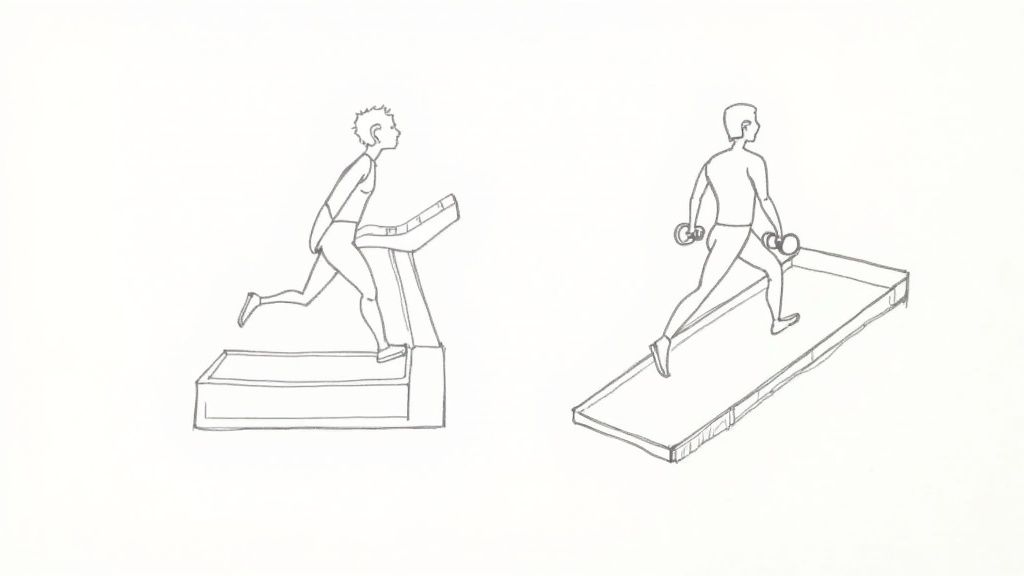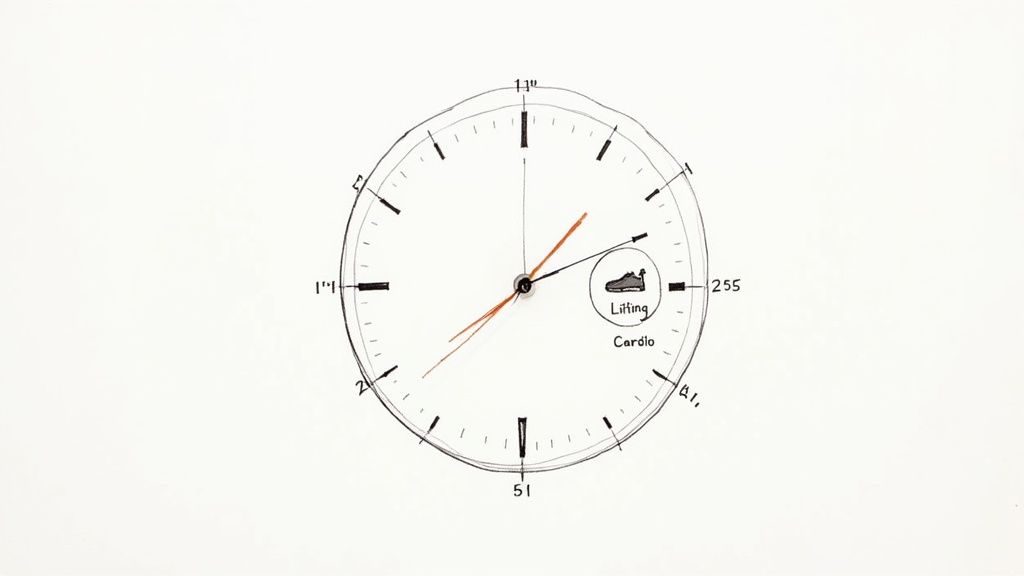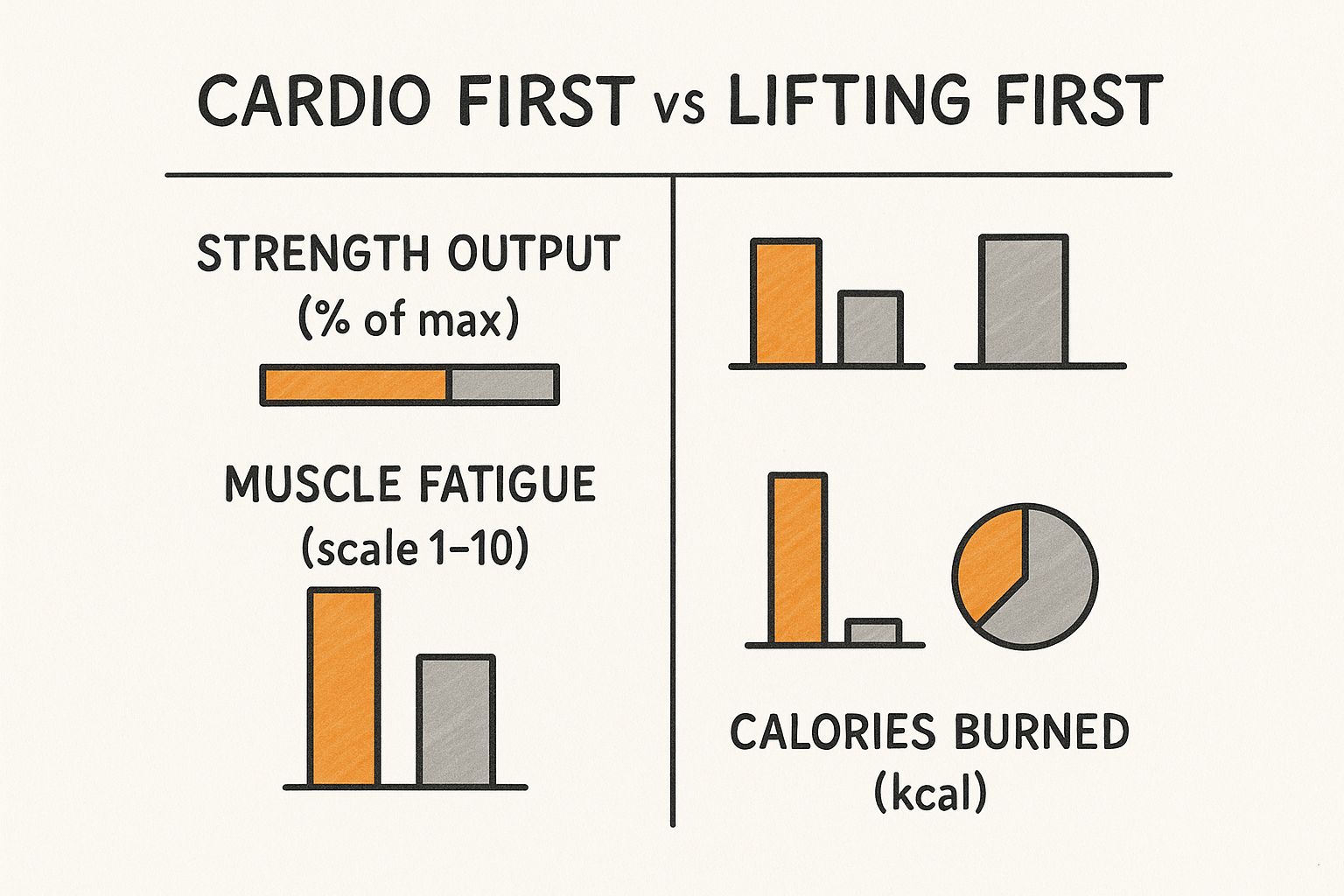
In short 👇🏽
Cardio and Lifting Same Day: A Practical Guide
This article is proposed by Gymkee, the personal trainer software that allows you to deliver the best coaching experience to your clients while saving time and growing your personal training business.
Try Gymkee for free for 14 daysCan you do cardio and lift weights on the same day?
Yes. But you have to be smart about it. The golden rule is simple: prioritize your main goal.
If you’re trying to get stronger, lift first. If you’re training for a 10k, run first. Tackle your most important workout when you’re fresh.
Understanding the Cardio and Lifting Same Day Dilemma

There's an old fear that cardio will "kill your gains." The reality is more nuanced. Combining both types of training is an efficient way to improve overall fitness, provided you have a plan.
The key is managing the interference effect.
Think of your body's energy and recovery resources like a limited daily budget. Strength training and cardio are two different expenses drawing from the same account:
- Lifting signals your body to build bigger, stronger muscles.
- Cardio signals your body to improve oxygen use and endurance.
Doing both back-to-back can send mixed signals, which might slightly compromise your results in one area.
The interference effect suggests that concurrent strength and endurance training can blunt adaptations for one or both. However, modern research shows this effect is minimal and manageable with smart programming.
Strategic planning is the solution. By being intentional about workout order, intensity, and timing, you can pursue both goals without wrecking your progress. It’s not about choosing one over the other; it’s about allocating your energy wisely.
This guide provides a practical framework for making it work. Here’s a quick cheat sheet to start.
Quick Guide to Combining Cardio and Lifting
This table breaks down how to structure your workouts based on your primary goal. Use it as a starting point for building a smarter weekly schedule.
The "best" approach depends on what you want to accomplish. With the right plan, you don't have to choose between being strong and having great cardiovascular fitness. You can have both.
Why Your Workout Order Is So Important
Combining cardio and lifting same day is about more than just finding the time; it’s about understanding the different biological signals you’re sending your body.
Each type of exercise triggers a unique chain reaction. When you lift weights, you activate a key pathway for muscle growth called mTOR. Heavy lifting turns this switch on, firing up protein synthesis—the process of repairing and growing muscle. It’s a direct order: get bigger and stronger.
Endurance cardio sends a different memo. It activates a pathway known as AMPK, which is focused on energy efficiency. This signal tells your body to prioritize fuel economy and endurance over building new muscle mass.
The Problem with Mixed Signals
When you perform a tough cardio session right before lifting, these competing signals can interfere with each other.
Your body gets a loud "efficiency" signal from the cardio, which can turn down the volume on the "build bigger" signal from your weight training. This is the core of the interference effect.
It’s not just a theory. Pushing through a hard run and then heading to the squat rack can negatively impact your strength goals.
The sequence of your workouts directly influences which adaptive signals your body prioritizes. Getting the order wrong can leave potential muscle and strength gains on the table.
Evidence shows that pre-fatiguing your muscles with cardio can impair lifting performance. One key study found that performing 20 minutes of aerobic exercise before compound lifts like squats and bench press led to a significant drop in strength and hypertrophy outcomes.
Specifically, doing cardio first resulted in a 31% reduction in muscle growth and an 18% decrease in strength gains. Participants also performed up to 20% fewer repetitions simply because they were already tired.
Protecting Your Strength Gains
That drop in performance is a major problem because it hinders progressive overload—the fundamental principle of getting stronger. If you’re too gassed from cardio to lift with the intensity needed for muscle growth, you won’t see the results you want.
While a good program requires varied movements, knowing which fitness exercises to prioritize is crucial for long-term success.
The takeaway is clear: if building muscle and strength is your main goal, your workout order is a fundamental piece of your strategy.
By lifting before cardio, you ensure your muscles receive a powerful, undiluted signal to grow, allowing you to give maximum effort when it matters most.
How to Time Your Workouts for Better Results

Knowing why to separate your workouts is one thing. Knowing how to schedule them is where progress happens.
The most effective strategy for combining cardio and lifting on the same day is to create a buffer zone.
Giving your body time to recover and reset between different types of training minimizes the interference effect. Think of it like rebooting a computer: after running a demanding program (your first workout), you give the system time to close old processes before launching the next one. This ensures both tasks run smoothly without competing for resources.
The Science of Separation
Your body works similarly. After a tough lifting session, muscle-building signals are high. After a hard run, endurance pathways are active. A buffer zone lets one set of signals quiet down before you activate the next, ensuring each message is received clearly.
So, what is the ideal separation time? The evidence points to a clear, actionable rule.
Creating a recovery window of at least three hours between cardio and strength training allows your body to optimize its response to each workout. This simple scheduling tactic can make a significant difference in your long-term results.
This isn't just theory. A 2021 meta-analysis looked at how timing affects strength gains when doing cardio and lifting same day. Researchers found that when aerobic exercise and lifting were performed back-to-back (within 20 minutes), lower-body strength development was significantly blunted.
However, when the sessions were separated by at least 3 hours, the interference effect on strength disappeared. You can review the full research on concurrent training effects to see the data for yourself.
Practical Scheduling Options
This principle gives you two primary, effective ways to structure your training day. Both options respect the recovery buffer and help you get the most out of each session.
Option 1: Morning Cardio, Evening Lifting. A popular split that works well with a flexible schedule. Get your cardio done in the morning and hit the weights in the afternoon or evening.
Option 2: Morning Lifting, Evening Cardio. If strength or muscle gain is your top priority, lift first thing when you're freshest. Then, complete your cardio session later in the day.
Both approaches are effective because they give your body the time it needs to transition. The best choice is the one that fits your lifestyle and energy levels—the one you can stick with consistently.
Designing Your Ideal Weekly Workout Split
A solid plan is what gets results.
Structuring your week correctly is the final piece of the puzzle when doing cardio and lifting on the same day. It’s about matching your schedule to your primary goal, whether that's building raw strength, improving overall health, or training for an endurance event.
A good split ensures you have the energy for each workout and the time for recovery. Below are three templates. Pick the one that aligns with your goals and adapt it to your life.
For Maximum Muscle And Strength
If getting stronger and building muscle is your top priority, your schedule must protect your lifting sessions. Heavy lifting always comes first, and intense cardio is placed strategically to avoid interfering with muscle recovery.
- Monday: Upper Body Strength (Lifting) + 20 min LISS Cardio post-lift
- Tuesday: Lower Body Strength (Lifting)
- Wednesday: Active Recovery or Complete Rest
- Thursday: Upper Body Hypertrophy (Lifting) + 20 min LISS Cardio post-lift
- Friday: Lower Body Hypertrophy (Lifting)
- Saturday: 30-45 min Moderate Intensity Cardio (Separate Session)
- Sunday: Complete Rest
For Balanced Fitness And Health
This approach is for those who want it all: strength, a healthy heart, and general fitness without specializing. The order is less critical, and combining moderate sessions works well.
- Monday: Full Body Strength Training (Lift First) + 25 min Moderate Cardio
- Tuesday: Rest or Light Activity (e.g., a long walk)
- Wednesday: 45 min Moderate to High-Intensity Cardio
- Thursday: Full Body Strength Training (Lift First) + 25 min Moderate Cardio
- Friday: Rest or Light Activity
- Saturday: Full Body Strength Training or a Fun, Active Hobby
- Sunday: Complete Rest
This image breaks down how workout order impacts key factors like strength output, muscle fatigue, and calorie expenditure.

As shown, lifting first preserves maximum strength. In contrast, doing cardio first increases immediate muscle fatigue, which can compromise your lifts.
For Endurance With Strength Maintenance
If you're training for a race, cardio is the priority. Lifting becomes a supporting activity, scheduled to maintain muscle mass and prevent injuries without causing fatigue that harms your main endurance workouts.
When endurance is the goal, strength training shifts from a primary objective to a crucial support system. It builds resilience and power without draining the tank for your main event.
- Monday: Endurance Run/Cycle (Primary)
- Tuesday: Full Body Strength (Lighter weight, higher reps)
- Wednesday: Tempo or Interval Run/Cycle (Primary)
- Thursday: Rest or Active Recovery
- Friday: Full Body Strength (Lighter weight, higher reps)
- Saturday: Long Endurance Run/Cycle (Primary)
- Sunday: Complete Rest
These templates are a starting point.
To dial in your plan, using a dedicated workout builder can help you log exercises, track progress, and adjust your split. Ultimately, consistency and listening to your body are what matter most.
Fueling Your Body for Two-a-Day Training
Doing cardio and lifting on the same day is demanding. Your nutrition and recovery must be dialed in. You’re asking more from your body, so you must give it the right fuel to perform, recover, and adapt.
Proper fueling is a non-negotiable part of the plan. Your nutrition must provide enough energy for both workouts and the raw materials to repair muscle afterward. This comes down to smart timing and the right balance of macronutrients.
Pre-Workout and In-Between Fuel
For fuel before and between sessions, easily digestible carbohydrates are your best option. Carbs are your body's preferred source of quick energy, ideal for powering a workout without causing digestive issues.
For example, a banana or a small bowl of oatmeal 30-60 minutes before a morning run can provide the immediate energy you need. If you're lifting later in the day, a similar small, carb-focused snack beforehand is effective.
What you do between sessions is just as critical. You need to kickstart recovery immediately. A snack or shake with both protein and carbs is ideal. A protein shake with a piece of fruit or some Greek yogurt begins repairing muscle tissue and replenishing the energy you just burned.
Your post-workout meal isn’t just about recovering from the session you finished; it’s about preparing your body for the one still to come. Front-loading your recovery is key.
Post-Workout Recovery and Hydration
After your final workout of the day, the mission shifts to repair and replenishment. A complete meal is a must. Aim for a balanced plate that covers all your bases:
- Lean Protein: To repair muscle fibers broken down during your lift (e.g., chicken, fish, tofu).
- Complex Carbohydrates: To restock muscle glycogen—the fuel stored in your muscles (e.g., sweet potatoes, quinoa, brown rice).
- Healthy Fats: To support hormone function and reduce inflammation (e.g., avocado, nuts, olive oil).
Don't forget water. Hydration is crucial. Even slight dehydration can crush your performance and slow recovery. Sip water consistently all day, not just when you feel thirsty during workouts.
Getting this right consistently can be tricky. Using a nutrition builder to create a personalized meal plan helps remove the guesswork, ensuring you hit your targets day after day.
Common Questions About Cardio and Lifting

Even with a solid plan, questions will come up when you start mixing cardio and lifting on the same day. Here are straightforward answers to the most common ones.
What Type of Cardio Is Best on Lifting Days?
When combining training, the type of cardio matters. Your best bet is low-to-moderate intensity, low-impact work. Think incline walking on a treadmill, using a stationary bike, or the elliptical.
These methods are easier on your central nervous system and won't drain your recovery resources like high-intensity options such as sprints or HIIT. Save that heavy-duty cardio for non-lifting days.
How Long Should My Cardio Session Be?
On days you lift, a 20-30 minute cardio session at a moderate pace is the sweet spot.
This is long enough to get cardiovascular benefits but not so long that you deplete the muscle glycogen needed for a strong lifting session. It prevents excessive fatigue, which is key for recovery and growth.
The goal of cardio on a lifting day is to support your health without sabotaging your strength. Shorter, controlled sessions are the key to this balance.
Should I Do a Cardio Warm-Up Before Lifting?
Yes, but understand the difference between a warm-up and a workout. A light, 5-10 minute cardio warm-up is essential.
The goal isn't to tax your system; it's to prepare it. A short warm-up increases blood flow to your muscles, raises your core body temperature, and mobilizes your joints. It improves lifting performance and helps prevent injuries without causing the interference effect.
Ready to build and manage your workouts without the guesswork? Gymkee provides all the tools you need to design effective training programs for your clients, track their progress, and grow your coaching business. See why over 3,000 trainers trust us to deliver exceptional results. Start your free 14-day trial today!
.svg)